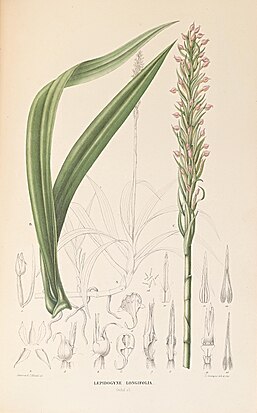Lepidogyne
| Lepidogyne | ||||||||||||
|---|---|---|---|---|---|---|---|---|---|---|---|---|

Illustration in: Carl Ludwig Blume Collection des Orchidées les plus remarquables de l'archipel Indien et du Japon (1858) |
||||||||||||
| Systematics | ||||||||||||
|
||||||||||||
| Scientific name | ||||||||||||
| Lepidogyne | ||||||||||||
| flower |
Lepidogyne is a genus from the family of the orchid (Orchidaceae). It consists of only one to three types of herbaceous plants that are native to tropical Southeast Asia.
description
The species of the genus Lepidogyne are relatively large, terrestrial orchids. The rhizome is short and strong, the stem axis is densely leafed. The leaves are oblong-lanceolate, at the base they run into a broad petiole that half encloses the shoot. The leaves are in a basal rosette and are up to 50 cm long in Lepidogyne longifolia ; the whole plant reaches a height of one meter or more. Worse reports from Papua New Guinea that Lepidogyne sceptrum is up to two meters high .
The racemose inflorescence is terminal. The inflorescence axis, the bracts , the ovary and the outside of the sepals are hairy. The showy bracts are longer than the flowers . The flowers are resupinated , the ovary is twisted. The petals are not fused together. The lateral sepals lie against the lip or are spread apart. The petals are asymmetrically oval-rhombic, they adhere to the upper petal. The lip is divided into two parts: the basal part, the hypochil, is sack-shaped, with six conical appendages inside. The edges of the hypochil point upwards and end in two short side lobes. The front part of the lip, the epichil, adjoins without a central part and is elongated-triangular. The lower third of the column is fused with the lip. The stamen is narrow oval to lanceolate with a heart-shaped base. It contains two club-shaped pollinia , the stalks of which adhere to a common lanceolate adhesive disc (Viscidium). The scar consists of an area. The lower edge of the scar surface is enlarged to form a plate-shaped, fleshy membrane that partially covers the scar. The separating tissue between the stigma and the stamen (rostellum) is triangular and incised at the tip.
Occurrence
Lepidogyne is native to Southeast Asia. The distribution area extends from Malaysia and the Philippines over Indonesia to Papua New Guinea. Altitudes from 500 to 1300 meters are populated. The locations are in the shade of forests and bushes, Lepidogyne also occurs in secondary forests . The plants grow on humus-rich or boggy soils. Comber reports a frequent occurrence from Java.
Systematics and botanical history
Lepidogyne is classified within the tribe Cranichideae in the subtribe Goodyerinae . According to Dressler, this can be further divided into two groups; Lepidogyne is in the larger group with only one scar area. The genera Goodyera and Hylophila are closely related. A distinguishing feature of Lepidogyne is the "plate" above the scar - however, in the genus Goodyera there are species with raised edges around the scar, and in Hylophila there are two appendages to the side of the scar.
The genus Lepidogyne was established in 1858 by Carl Ludwig Blume . The name comes from the Greek λεπίς lepis , "scales", and γυνῄ gyne , "woman", it refers to the tissue above the scar surface. The type species is Lepidogyne longifolia , which Blume had previously described as Neottia longifolia .
So there is only one type:
- Lepidogyne longifolia (flower) flower (Syn .: Neottia longifolia flower , Lepidogyne minor Schltr. , Lepidogyne sceptrum Schltr. ): It occurs in Malaysia, the Philippines, Sumatra, Java, Borneo and New Guinea.
See also
literature
- Alec M. Pridgeon, Phillip Cribb, Mark W. Chase, Finn Rasmussen (Eds.): Genera Orchidacearum. Orchidoideae (Part 2). Vanilloideae . tape 3 . Oxford University Press, New York / Oxford 2003, ISBN 0-19-850711-9 , pp. 110-114 .
Individual evidence
- ↑ a b c d Paul Ormerod, Phillip Cribb, Alec Pridgeon: Lepidogyne . In: Genera Orchidacearum . Vol. 3, pp. 110-114.
- ↑ Jim B. Comber: Orchids of Java . Bentham-Moxon Trust, Kew 1990, ISBN 0-947643-21-4 , pp. 34 .
- ^ Rudolf Schlechter: The Orchidaceae of German New Guinea . In: Friedrich Fedde (Ed.): Repertorium Specierum Novarum Regni Vegetabilis. Booklets . tape 1 . Bornträger, Dahlem 1911, p. 54 ( archive.org ).
- ^ Robert L. Dressler: Phylogeny and Classification of the Orchid Family . Cambridge University Press, 1993, ISBN 0-521-45058-6 , pp. 118 .
- ↑ Rafaël Govaerts (ed.): Lepidogyne. In: World Checklist of Selected Plant Families (WCSP) - The Board of Trustees of the Royal Botanic Gardens, Kew . Retrieved July 13, 2018.